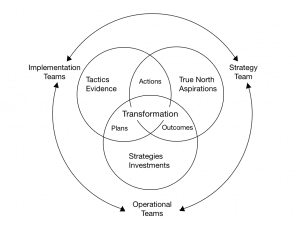I came up with an initial diagram to visually summarise Strategy Deployment when I wrote about the dynamics. However, while it showed some of the collaborative elements, I never felt it was sufficient, and still had a hint of hierarchy about it that I didn’t like.
More recently, while reading “Understanding Hoshin Kanri: An Introduction by Greg Watson“, I saw a diagram I liked much more, and was inspired to tweak it to fit my understanding and experience of the approach.
Working from the outside of the picture…
The outer loop shows the people involved and their interactions as a collaboration rather than as a hierarchy. Whilst levels of seniority are represented, these levels describe the nature of decisions being made. Thus the three primary groups are the Leadership Team, Operational Teams and Implementation Teams which reflect the three primary roles in Catchball, and which are responsible for co-creating and owning the various A3 Templates. The bi-directional arrows between these teams show how they collaborate to discover, negotiate and agree on the Outcomes, Plans and Actions. (Note: the original diagram had the arrows only going clockwise, which suggested a directing and reporting dynamic to me).
The three inner circles show the main focuses of each team. The Strategy Team set direction through the True North and Aspirations. The Operational Teams maintain alignment to the intent of the Strategies by making Investments in improvement opportunities. The Implementation Teams have autonomy to realise the strategies by determining and carrying out Tactics and generating Evidence of progress.
The intersections of these circles map onto the three elements of Stephen Bungay’s Directed Opportunism (from his book “The Art of Action”), and they describe the essence of the collaboration between the different groups. The Strategy Team and Operational Teams work together to establish positive Outcomes. The Operational Teams and Implementation Teams work together to define plausible Plans. The Implementation Teams and Strategy Team work together to review the results of the Actions.
Finally, the central intersection of all the circles, and the combination of all of these elements, is a continuous Transformation – the result of everyone working together with both alignment and autonomy.
Given this visualisation, we can also overlay the three A3 Templates on top, showing which teams have primary responsibility for each.
Like all diagrams, this is a simplification. Its the map, and not the territory. The collaborations are not as separate and clear cut as it might imply. Rather, much of this work is emerging and evolving, collectively and simultaneously. I still believe, however, that it is a useful picture of Strategy Deployment as “any form of organisational improvement in which solutions emerge from the people closest to the problem.”


